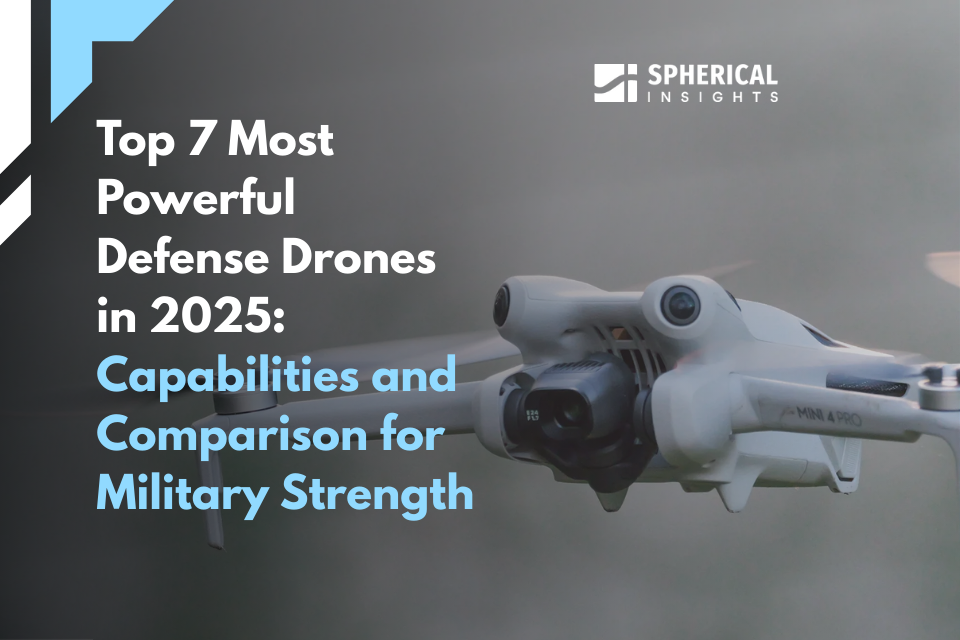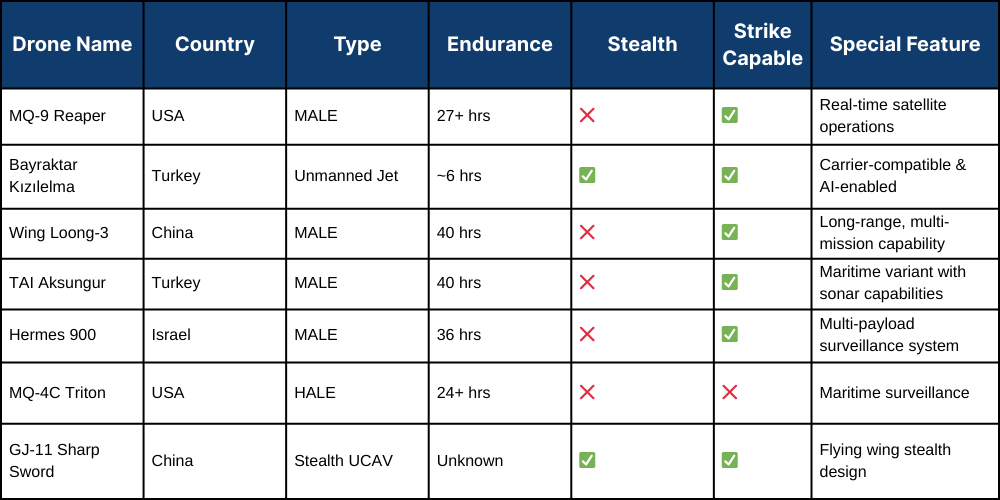
Top 7 Most Powerful Defense Drones in 2025: Company Profiles, Global Market Share, Demand and Price Analysis
RELEASE DATE: May 2025 Author: Spherical InsightsRequest Free Sample Speak to Analyst
Overview
Defense drones are now essential assets for surveillance, targeted strikes, and real-time intelligence collection in the dynamic battlefield of today. As AI, stealth technology, and autonomous systems develop quickly, drones are revolutionizing military operations worldwide. Every model, from highly armed stealth UCAVs to long-endurance surveillance UAVs, is made with unique characteristics to meet a range of mission requirements. In order to comprehend how the top military drones of 2025 influence contemporary conflict and national defense plans, this blog compares their salient characteristics, technological advantages, and strategic functions.
Comparison table of the top defense drones in 2025

The Global Military Drone Market size is anticipated to exceed USD 38.21 Billion by 2032, growing at a CAGR of 11.9% from 2022 to 2032. Click Here To Read More
The 7 Most Advanced Defense Drones of 2025
1. MQ-9 Reaper
The U.S. Air Force's main weapon is the General Atomics MQ-9 Reaper, also known as Predator B. It is built for precise strike and long-range, high-altitude surveillance operations. Compared to its predecessor, the MQ-1 Predator, this unmanned aerial vehicle (UAV) is a major improvement and can fly autonomously or under remote control. With a powerful 950-shaft-horsepower turboprop engine, the Reaper can operate at three times the speed and carry fifteen times as much ordnance as the MQ-1, making it an extremely useful weapon in contemporary warfare.
Capabilities -
The MQ-9 Reaper is a hunter-killer UAV that can be used for dynamic and urgent missions in addition to being a surveillance drone. It is equipped with the Multi-Spectral aiming System (MTS-B), which combines a laser designator, color and monochrome daytime TV cameras, and an infrared sensor to provide accurate aiming. Up to eight laser-guided Air-to-Ground Missile-114 Hellfire missiles, which are renowned for their accuracy and minimal collateral damage, can be used by the aircraft. The Reaper can also be equipped with extra fuel tanks to increase its operational time and range, which will further improve its capacity to carry out continuous missions over large areas.
2. Bayraktar TB2
The Baykar-created Bayraktar TB2 is a noteworthy advancement in unmanned aerial vehicle technology. To address a range of operational requirements, this tactical armed/unmanned aerial vehicle system incorporates a full portfolio of options. It is a Medium Altitude Long Endurance (MALE) drone that can carry out armed attack missions in addition to Intelligence, Surveillance, and Reconnaissance (ISR) operations. It is noteworthy for being the first aircraft in its class to be exported outside, demonstrating its efficacy and global influence.
Capabilities -
The Bayraktar TB2 can do fully autonomous tasks like taxiing, takeoff, landing, and cruising due to its triple redundant avionic system and sophisticated sensor suite. The drone's four hardpoints allow it to carry laser-guided weapons like the Roketsan MAM-L and MAM-C. It has advanced technology that improves its operational capabilities, including as IFF transponders and the Osprey AESA radar. During missions, the UAV's fault-tolerant and redundant systems guarantee great reliability and safety.
Applications in Operations
The Bayraktar TB2's combat capabilities have been demonstrated through its active deployment in a number of conflict zones, such as Syria, Libya, and Nagorno-Karabakh. It is an invaluable tool for military operations due to its capacity to carry out accurate strikes with little collateral damage. The drone's long endurance (up to 27 hours) enables prolonged operations and continuous aerial research and surveillance. Its reputation as a "Combat Proven" UAV on the global scene has been cemented by its critical role in taking out air defenses, radar sites, armored vehicles, and other valuable targets.
3. Wing Loong II
The Chengdu Aircraft Industry Group in China created the advanced unmanned aerial vehicle (UAV) known as the Chengdu GJ-2, or Wing Loong II. This UAV, which was first unveiled in September 2015 at the Aviation Expo China in Beijing, is mainly intended for operations involving precise strikes, aerial reconnaissance, and surveillance. With a longer body and wider wingspan than its predecessor, Wing Loong I, it is an evolution that improves its operational capabilities.
Capabilities -
The cutting-edge technology included in Wing Loong II enables completely autonomous operations, including as cruising, takeoff, landing, and taxiing. Because each wing has three hardpoints that can carry bombs, rockets, or air-to-surface missiles, the UAV has a large payload capacity. For long-distance data transmission, it is notable for having a satellite communications antenna installed on the fuselage. With its turbocharged engine, this unmanned aerial vehicle (UAV) can fly for up to 20 hours at a maximum speed of 370 km/h. Its operational radius is 1,500 km.
4. Turkish Aerospace Industries (TAI)
Turkish Aerospace Industries (TAI) designed and manufactures the medium-altitude long-endurance (MALE) unmanned aerial vehicle (UAV) known as TAI Aksungur. Aksungur is an advancement from Turkey's smaller UAV models and is positioned as a substitute for the American-made MQ-9 Reaper. Twelve units were delivered by 2023, having been used by the Turkish Air Force and the Kyrgyz Border Guard since its initial delivery to the Turkish Naval Forces on October 20, 2021.
Capabilities -
Aksungur is distinguished by its exceptional endurance, which gives it a major edge over many of its rivals. It can fly for up to 50 hours on a single mission. It is built to carry out a number of tasks, such as intelligence, surveillance, and reconnaissance (ISR), and it can be equipped to carry out striking missions. With a payload capacity of up to 750 kg, the drone may carry a variety of sensors and missiles, enabling a flexible operational profile.
5. Israeli Hermes 900
The Israeli company Elbit Systems, which is well-known for its defense technologies, invented and produced the extremely sophisticated unmanned aerial vehicle (UAV) known as the Elbit Hermes 900. A development of the previous Hermes 450 model, this UAV offers improved performance and more features. It is perfect for both military and civilian purposes because it is made for medium altitude long endurance (MALE) missions.
Capabilities -
The Hermes 900 can fly up to 30,000 feet because to its strong engine and cutting-edge avionics. It can carry a wide range of sensors and equipment, such as synthetic aperture radars, signal intelligence systems, and electro-optical/infrared sensors, due to its substantial payload capacity. With a maximum flight time of 36 hours, this UAV offers wide coverage and extended operational capabilities.
6. MQ-4C Triton
A major advancement in unmanned aerial vehicle technology, the Northrop Grumman MQ-4C Triton was created especially for maritime surveillance. By offering thorough real-time intelligence, surveillance, reconnaissance, and targeting (ISR&T) over extensive oceanic and coastal regions, this high-altitude, long-endurance system improves the capabilities of the Royal Australian Air Force and the U.S. Navy. In a time where security risks are constantly changing, its adoption represents a significant development in preserving marine domain awareness.
Capabilities -
The MQ-4C Triton offers exceptional operational flexibility due to its advanced 360-degree sensor suite. It is capable of operating at altitudes above 50,000 feet, which is far higher than conventional medium-altitude, long-endurance (MALE) aircraft and commercial aviation. This feature greatly improves maritime domain awareness by allowing the deployment of sophisticated sensors. In order to increase its operational range and guarantee continuous monitoring, the Triton's speed and endurance are designed to improve its capacity to anticipate and react to hostile activities without endangering the lives of its crew.
7. GJ-11 Sharp Sword
The next generation stealth Unmanned Combat Aerial Vehicle (UCAV) for deep-penetration strike missions is the GJ-11 Sharp Sword, created by China's Aviation Industry Corporation of China (AVIC). China's unmanned stealth capabilities have evolved significantly with the drone's sophisticated flying-wing design and low radar signature. With its attacking powers and near-invisible nature, it is designed for use in high-threat scenarios.
Capabilities -
The GJ-11 can carry precision ordnance without sacrificing radar invisibility due to its internal weapons bays and stealth-optimized airframe. For autonomous operations, including as strike missions and route planning in contested airspace, it makes use of AI-powered navigation and targeting systems. The Sharp Sword is a vital tool for upcoming air combat and strategic missions because of its great survivability and innovative design, which enable it to deliver precise attacks and avoid enemy notice.
Browse Related Reports:
- Global Supersonic Jet Market Size By Type (Fighter, Passenger), By Speed (1.0 mach, 2.0 mach, 3.0 mach), By Platform (Commercial Aircraft, Military Aircraft), By Region, And Segment Forecasts, By Geographic Scope And Forecast to 2033.
- Iran Surveillance Drone Market Size, Share, and COVID-19 Impact Analysis, By Type (Multirotor, Fixed Wings), By Application (Offshore Platform Inspection, Pipeline Monitoring & Inspection), and Iran Surveillance Drone Market Insights Forecasts to 2033.
- Iran Fighter Jet Market Size, Share, and COVID-19 Impact Analysis, By Aircraft Type (Fixed-Wing, Rotorcraft), By Take-Off & Landing (Conventional Take-off and Landing, Short Take-off and Landing, Vertical Take-off and Landing), and Iran Fighter Jet Market Insights Forecasts 2023 – 2033.
- Global Scramjet Market Size, Share, and COVID-19 Impact Analysis, By Type (Around Mach 3, Around Mach 6, Others), By Application (Supersonic or Hypersonic Transportation, Military Applications, Others), and By Region (North America, Europe, Asia-Pacific, Latin America, Middle East, and Africa), Analysis and Forecast 2023 - 2033.
-
Global Drone Market Size, Share, and COVID-19 Impact Analysis, By Type (Fixed Wing Drone, Rotary Wing Drone), By Product Type (Commercial Drone, Military Drone, Other Types), By Propulsion (Heat Engine, Electrical Engine, Jet Engines, Others), By Application (Construction, Agriculture, Aerial Surveying, Entertainment, Combat Operations, Border Security, Law Enforcement, Other Applications) and By Region (North America, Europe, Asia-Pacific, Latin America, Middle East, and Africa), Analysis and Forecast 2021 – 2030.
About the Spherical Insights & Consulting
Spherical Insights & Consulting is a market research and consulting firm which provides actionable market research study, quantitative forecasting and trends analysis provides forward-looking insight especially designed for decision makers and aids ROI.
Which is catering to different industry such as financial sectors, industrial sectors, government organizations, universities, non-profits and corporations. The company's mission is to work with businesses to achieve business objectives and maintain strategic improvements.
CONTACT US:
For More Information on Your Target Market, Please Contact Us Below:
Phone: +1 303 800 4326 (the U.S.)
Phone: +91 90289 24100 (APAC)
Email: inquiry@sphericalinsights.com, sales@sphericalinsights.com
Contact Us: https://www.sphericalinsights.com/contact-us
Need help to buy this report?